
CNC programming refers to the process of creating instructions (often in the form of G-code) that a CNC machine follows to perform operations such as cutting, drilling, milling, and shaping materials. Here’s an overview of CNC programming, its components, and how it works:
Components of CNC Programming
- CAD (Computer-Aided Design):
- Design Creation: The initial step involves creating a detailed digital model or drawing of the part or component using CAD software.
- Dimensions and Geometry: Define the dimensions, shapes, and geometry of the part to be manufactured.
- CAM (Computer-Aided Manufacturing):
- Toolpath Generation: CAM software translates the CAD model into machine-readable instructions.
- G-code Generation: Converts the design into a series of commands (G-code) that the CNC machine can interpret.
- G-code:
- Programming Language: G-code is a standardized programming language used to control CNC machines.
- Commands: Includes commands for movement along different axes (X, Y, Z), tool selection, spindle speed, feed rate, coolant activation, and other parameters.
- Manual and Automated Programming: G-code can be generated manually or automatically through CAM software.
[elementor-template id=”4330″]
How CNC Programming Works
- Design Preparation:
- Create a detailed design of the part or component using CAD software.
- Define the dimensions, tolerances, and specifications required for the part.
- Toolpath Generation:
- CAM software analyzes the CAD model and generates toolpaths based on the desired operations (cutting, drilling, milling, etc.).
- Optimizes toolpaths for efficiency, minimizing unnecessary movements and reducing machining time.
- G-code Generation:
- CAM software generates G-code based on the toolpaths and machine specifications.
- G-code includes specific commands for each operation, detailing tool movements, spindle speeds, feed rates, and other parameters.
- Machine Setup:
- Load the G-code file into the CNC machine’s controller.
- Securely mount the workpiece and select the appropriate cutting tools.
- Execution:
- The CNC machine’s controller reads and executes the G-code instructions.
- Automated movements of the machine’s axes and tools perform the programmed operations on the workpiece.
- Continuous monitoring ensures accuracy and adjusts parameters as necessary.
Importance of CNC Programming
- Precision and Accuracy: CNC programming ensures precise control over tool movements and operations, producing parts with consistent quality.
- Efficiency: Optimized toolpaths and parameters reduce material waste and machining time.
- Flexibility: Easily modify programs for different parts and prototypes without the need for physical tool changes.
- Automation: Minimizes human error and increases productivity by automating repetitive tasks.
Applications of CNC Programming
- Manufacturing: Used in industries such as automotive, aerospace, medical, electronics, and consumer goods for mass production and prototyping.
- Prototyping: Rapidly iterate designs and produce prototypes for testing and validation.
- Customization: Enables the production of complex and customized parts that are difficult to manufacture manually.
[elementor-template id=”4331″]
Conclusion
CNC programming is integral to modern manufacturing, enabling the precise control and automation of CNC machines. By translating design specifications into machine-readable instructions (G-code), CNC programming ensures efficient and accurate production of parts and components across various industries. Mastering CNC programming requires proficiency in CAD/CAM software and understanding of machining principles to optimize operations and achieve desired outcomes.
Related Conten: Custom Plastic Fabrication
 DTG Mould Trade Process |
|
| Quote: | According to sample, drawing and specific requirement. |
|---|---|
| Discussion | Mold material, cavity number, price, runner, payment, etc. |
| S/C Signature | Approval for all the items. |
| Advance | Pay 50% by T/T |
| Product Design Checking | We check the product design. If some position is not perfect, or can not be done on the mould, we will send customer the report. |
| Mold Processing | Send report to customer once each week |
| Mold Testing | Send trial samples and try-out report to customer for confirmation |
| Mold Modification | According to customer’s feedback. |
| Balance Settlement | 50% by T/T after the customer approved the trial sample and mould quality. |
| Delivery | Delivery by sea or air. The forwarder can be designated by your side. |
 |
|

